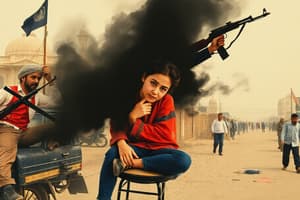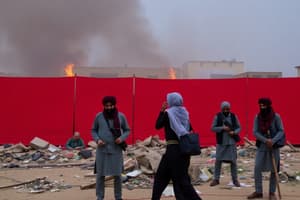Podcast
Questions and Answers
Considering the socio-political climate described within the text, what latent function did the act of huddling together during bombings serve for Malala and her family, beyond immediate emotional comfort?
Considering the socio-political climate described within the text, what latent function did the act of huddling together during bombings serve for Malala and her family, beyond immediate emotional comfort?
- It provided a guise for adults to subtly monitor children's emotional responses, enabling them to identify potential psychological trauma early on.
- It minimized individual exposure to shrapnel and debris, leveraging the collective body mass as a makeshift shield against external threats.
- It reinforced familial bonds, indirectly countering the Taliban's attempts to destabilize traditional societal structures through fear and violence. (correct)
- It facilitated the covert transmission of survival strategies and risk assessment techniques to younger family members.
In the context of the narrative, how does Malala's adaptation to the sounds of war reflect a psychological phenomenon exhibited by populations under prolonged siege, and what are the potential long-term implications?
In the context of the narrative, how does Malala's adaptation to the sounds of war reflect a psychological phenomenon exhibited by populations under prolonged siege, and what are the potential long-term implications?
- It represents 'Stockholm syndrome,' fostering a paradoxical allegiance to the aggressors as a coping mechanism, thereby undermining collective resilience.
- It demonstrates 'cognitive restructuring,' wherein individuals reframe traumatic experiences to maintain psychological equilibrium, potentially normalizing violence.
- It illustrates 'learned helplessness,' predisposing individuals to accept oppressive regimes as unchangeable realities and hindering future resistance efforts.
- It exemplifies 'desensitization,' reducing emotional reactivity to violence over time, which may compromise empathy and moral judgment in conflict resolution. (correct)
Given Malala's method of discerning the proximity of conflict zones based on electricity outages, and framing this as a 'system', what inference can be derived about the cognitive strategies employed by children in conflict zones to establish a sense of environmental predictability?
Given Malala's method of discerning the proximity of conflict zones based on electricity outages, and framing this as a 'system', what inference can be derived about the cognitive strategies employed by children in conflict zones to establish a sense of environmental predictability?
- Children employ Bayesian inference to iteratively refine their understanding of conflict patterns, dynamically updating risk assessments based on new information.
- Children utilize rudimentary 'if-then' heuristics to correlate readily observable events with potential threats, creating a simplified cognitive map of their surroundings. (correct)
- Children rely on game-theoretic approaches to optimize survival strategies, treating conflict zones as complex systems of competing actors and probabilistic outcomes.
- Children instinctively develop stochastic models to probabilistically forecast the spatiotemporal dynamics of conflict, minimizing exposure to danger.
What philosophical commentary emerges from Malala's escalating prayer requests—from her family to the entire world—regarding the nature of empathy, moral obligation, and the expanding circle of moral concern in the face of widespread suffering?
What philosophical commentary emerges from Malala's escalating prayer requests—from her family to the entire world—regarding the nature of empathy, moral obligation, and the expanding circle of moral concern in the face of widespread suffering?
How does the narrative employ the motif of light and darkness—specifically, the 'streak of bright white light' followed by bombings—to symbolize the intersection of technological advancement, religious extremism, and geopolitical conflict in the Swat Valley?
How does the narrative employ the motif of light and darkness—specifically, the 'streak of bright white light' followed by bombings—to symbolize the intersection of technological advancement, religious extremism, and geopolitical conflict in the Swat Valley?
Considering the psychological impact of prolonged exposure to conflict as portrayed in the text, assess how the children's adaptation mechanisms might manifest in the context of later-life socio-political engagement, particularly concerning reconciliation and transitional justice.
Considering the psychological impact of prolonged exposure to conflict as portrayed in the text, assess how the children's adaptation mechanisms might manifest in the context of later-life socio-political engagement, particularly concerning reconciliation and transitional justice.
In what ways does Malala's experience of war, as depicted in the excerpt, challenge conventional understandings of childhood innocence and vulnerability, compelling a re-evaluation of developmental psychology's assumptions within conflict zones?
In what ways does Malala's experience of war, as depicted in the excerpt, challenge conventional understandings of childhood innocence and vulnerability, compelling a re-evaluation of developmental psychology's assumptions within conflict zones?
Given the historical context surrounding the events described, what potential unintended consequences might arise from the army's actions of 'driving the Taliban into hiding,' concerning the long-term stability and governance of Swat Valley?
Given the historical context surrounding the events described, what potential unintended consequences might arise from the army's actions of 'driving the Taliban into hiding,' concerning the long-term stability and governance of Swat Valley?
How does the narrative's juxtaposition of the children developing 'a system to figure out where the fighting was' with Malala reciting protective verses from the Quran illustrate the interplay between rational empiricism and religious faith as coping mechanisms in conflict zones?
How does the narrative's juxtaposition of the children developing 'a system to figure out where the fighting was' with Malala reciting protective verses from the Quran illustrate the interplay between rational empiricism and religious faith as coping mechanisms in conflict zones?
Considering the narrative's emphasis on the disruption of daily life during wartime, what inferences can be drawn about the long-term consequences of such disruptions on the social capital and collective efficacy of affected communities, particularly concerning intergenerational transmission of knowledge and skills?
Considering the narrative's emphasis on the disruption of daily life during wartime, what inferences can be drawn about the long-term consequences of such disruptions on the social capital and collective efficacy of affected communities, particularly concerning intergenerational transmission of knowledge and skills?
Flashcards
Night of bombing
Night of bombing
A night filled with explosions and chaos in Swat.
Taliban
Taliban
A militant group that aimed to control regions in Pakistan.
Army's military operation
Army's military operation
The intervention made by the army to combat the Taliban.
Three types of attacks
Three types of attacks
Signup and view all the flashcards
Ayat al-Kursi
Ayat al-Kursi
Signup and view all the flashcards
System to track fighting
System to track fighting
Signup and view all the flashcards
Family prayers
Family prayers
Signup and view all the flashcards
Sounds of war
Sounds of war
Signup and view all the flashcards
Hope for peace
Hope for peace
Signup and view all the flashcards
Fate of others
Fate of others
Signup and view all the flashcards
Study Notes
Malala's Experiences During War
- The author recounts a night of bombing, describing the bright light, the loud noise, and the ensuing chaos
- Families huddled together during the attack, shaken by the blasts and the rattling of windows
- The author and her family experienced multiple types of attacks, including bombings (sometimes by remote control, or suicide bombers), shelling, or machine gun fire
- The Taliban were fighting in the region and were reportedly trying to take control of the area
- The military operation was initially unsuccessful, causing fear and anxiety in the community
- A significant military operation took place lasting for years
- Families had to adjust to living conditions after the war, such as sleeping on blankets on the floor due to the crowded nature of the living spaces
- The author's experiences and prayers highlight how people cope with war and fear
Prayers and Hope
- The author mentions reciting a specific verse from the Holy Quran to protect her home.
- Repeated prayers were said to protect their neighborhood and wider community.
- The author maintained hope for peace and safety, even during difficult times
- Prayers were offered for various people, including family, neighborhood, area and wider community
- The author was grateful that they often woke up unharmed from the night's attacks
- The author’s prayers sometimes seemed to be answered
Studying That Suits You
Use AI to generate personalized quizzes and flashcards to suit your learning preferences.




